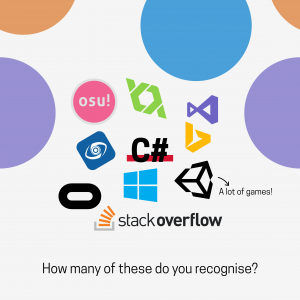It’s time for round 2! This time we’re spotlighting programming languages! They’ve been the building blocks for a significant amount of what we do in IMGD, bringing many ideas to life and many tears to our eyes (we’ll let you decide if it’s for better or worse :D).
Since IMGD has 2 different specializations, we’ll be talking about 2 languages: JavaScript & C#, both heavily used.
Now, being programming languages, it’ll get a bit more technical. (Bear with us here)
JavaScript
Starting off with Javascript, commonly abbreviated as JS, along with its .js file suffix.
It’s a programming language used to make complex interactions and features on a webpage such as displaying content updates, interactive maps, videos, animating 2d/3d graphics and more. The sky’s the limit in terms of creativity, a true sandbox of code. Its main use is on webpages and it can be used across different browser applications.
Through our time in school learning the language, we used Javascript mainly to learn how to create a website from scratch, alongside other languages like HTML and CSS.
These 3 work together to form most of the websites that we see on the internet today!
C#
Moving on to C#, it is a language which was launched by Microsoft in 2001. A simple and modern language, it provided modern-day developers flexibility and features that work not just today, but also in the future.
It is an object-oriented programming language, which is a programming paradigm based on the concept of objects which store data in the form of attributes or properties.
To get less technical, C# is a programming language which revolves around the data stored, rather than functions and logic. The purpose of C# was to create a programming language that is not only easy to learn but also supportive of current functionality for all kinds of software development.
For us, we use C# mainly within Unity Engine, where we could program many interactions within the scene using just C#. These interactions include asset movement, collisions, event triggers, and many more.
More to it
The interesting thing during this research was that we underestimated the extent in which these two languages alone were used. A lot of the companies that many of us know and follow actually utilize them a lot.
You’ve got Unity which understandably uses C#, which then translates to many many games piggybacking on the Unity Engine. They also dominate a lot of the games created for the Samsung VR and Oculus Rift VR headsets.
More than a third of the top games in the world are Unity engine-created.
As to the extent, they boast a player base of approximately 770 million active users for these Unity-created games.
JavaScript has its own share of astonishing stats, as it is used in 95% of the world’s 1.6 billion websites; which means virtually any computing device you use, uses JavaScript.


With that we’re nearing the end of the Takeover! We still have some things left to come, so do be on the lookout!

